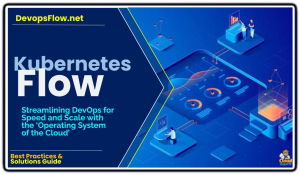Kubernetes Flow: Streamlining DevOps for Speed and Scale
Kubernetes, often abbreviated as K8s, is an open-source platform for automating the deployment, scaling, and management of containerized applications.
 In the fast-paced world of modern software delivery, where speed, reliability, and scalability are non-negotiable, Kubernetes has emerged as a game-changer.
In the fast-paced world of modern software delivery, where speed, reliability, and scalability are non-negotiable, Kubernetes has emerged as a game-changer.
Dubbed the “operating system of the cloud,” this open-source platform orchestrates containerized applications with unmatched precision, empowering teams to move from idea to production faster than ever before.
But Kubernetes is more than just a technical tool—it’s a catalyst for transforming the DevOps life-cycle into a seamless, flowing pipeline of innovation.
Kubernetes Flow explores how this powerful system accelerates the rhythm of DevOps work, breaking down silos, automating the mundane, and enabling teams to deliver value at scale. From rapid deployments to self-healing systems, Kubernetes aligns the principles of DevOps—collaboration, automation, and continuous improvement—with the realities of cloud-native architecture.
Cloud Native Architecture
A Cloud Native architecture significantly enhances the speed and efficiency of the DevOps life-cycle by leveraging modern cloud computing principles, tools, and practices. It’s built around the idea of designing applications specifically for the cloud, rather than adapting legacy systems, which aligns seamlessly with DevOps goals of collaboration, automation, and rapid delivery.
Cloud Native shrinks the cycle from code commit to production—sometimes to hours or minutes.
In essence, Cloud Native architecture turbocharges DevOps by making every stage—development, integration, deployment, and monitoring—more automated, scalable, and resilient. It’s like giving DevOps a high-octane engine: the core principles stay the same, but the execution becomes faster, smoother, and more efficient.
Deployment Automation
Kubernetes, often abbreviated as K8s, is an open-source platform for automating the deployment, scaling, and management of containerized applications. Its benefits are transformative for modern software development and operations, especially in Cloud Native environments.
Tools like Kubernetes, a cornerstone of Cloud Native, automate the deployment, scaling, and management of containerized applications. This reduces manual effort and enables rolling updates or blue-green deployments with minimal downtime.
Kubernetes automates the deployment and scheduling of containers across a cluster of machines. It decides where to run containers based on resource availability, constraints, and policies, saving manual effort. If a container crashes, Kubernetes automatically restarts it. If a node fails, it reschedules workloads elsewhere. This reduces downtime and ensures application reliability without human intervention.
Kubernetes supports seamless updates with zero downtime by gradually replacing old containers with new ones. It can also roll back changes automatically if something goes wrong. With cloud elasticity, teams can experiment, fail fast, and pivot quickly, aligning with DevOps’ iterative mindset.
Hyperscale Applications
Kubernetes can scale applications up or down by adding or removing container instances based on demand (e.g., CPU or memory usage). This ensures performance during traffic spikes and cost efficiency during lulls. It manages clusters of nodes (physical or virtual machines), allowing you to expand your infrastructure as needed without rearchitecting your app.
With multi-cloud and hybrid cloud support, Kubernetes lets you scale across different providers or on-premises setups effortlessly. Kubernetes runs consistently across public clouds (AWS, Azure, Google Cloud), private clouds, or bare metal, freeing you from vendor lock-in. It provides a uniform interface for managing containers, so applications can move between environments without significant changes.
Kubernetes distributes traffic across containers automatically, preventing any single instance from being overwhelmed and improving uptime. Built-in probes monitor container health and restart or replace them if they fail, maintaining service availability.
Practical Impact
- Faster Deployments: Automation and rolling updates shrink release cycles from days to minutes.
- Reduced Downtime: Self-healing and replication keep apps running smoothly, even under failure.
- Cost Efficiency: Better resource use and scalability lower operational expenses.
- Team Agility: Developers focus on code, not infrastructure, while ops teams manage clusters at scale.
- Rich Tooling: Kubernetes integrates with a vast ecosystem—CI/CD tools (Jenkins, GitLab), monitoring (Prometheus, Grafana), logging (ELK), and more—making it a hub for DevOps workflows.
- Strong Support: Backed by a massive open-source community and major tech companies, Kubernetes benefits from constant updates, security patches, and a wealth of documentation.
In short, Kubernetes acts like a super-smart manager for your containerized apps—handling the heavy lifting of deployment, scaling, and maintenance so teams can deliver reliable software faster. It’s the backbone of many Cloud Native setups for a reason: it’s powerful, flexible, and battle-tested.



